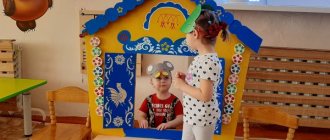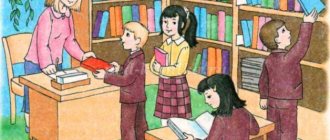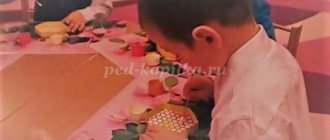In kindergarten, the teacher has the opportunity to use a wide variety of ways to teach coherent speech, but the main one is storytelling.
Typically, the following types of storytelling are distinguished:
- examination and description of toys and objects;
- storytelling based on the picture using leading questions;
- independently compiling stories from pictures;
- inventing continuations of stories or telling about what preceded them;
- talking about something from personal experience.
Teaching children creative storytelling begins with the preparatory work described above, which contributes to the acquisition of speech skills and helps them independently choose the development of the plot. Children learn to build subject-logical connections, a certain composition, and select the right words.
Creative storytelling
Creative storytelling is usually understood as storytelling based on proposed plots. In creative stories, children are asked to describe fictitious situations that did not actually happen. Children independently come up with fairy tales or stories, choosing the necessary images and situations within the framework of the topic given by the teacher.
The method of teaching preschoolers creative storytelling includes composing a creative story, when starting which children can be guided by:
- On real objects or pictures (What will happen next in the picture? What story can happen with toy animals?).
- For verbal instructions (write a story about how a puppy helped a kitten).
It is advisable to invite children to divide the story into two parts: first, talk about what actually exists, and then fantasize or remember something.
Children in the middle group are taught to correctly retell stories and fairy tales they have heard, and accurately describe objects and natural objects.
Children in the older group learn to compare objects with each other, tell stories from memory, compose stories from pictures, showing their imagination.
“We compose fairy tales” outline of a lesson on speech development (preparatory group) on the topic
Lesson summary on speech development
in the preparatory school group "Bell"
on the topic: “We make up fairy tales”
Conducted by teacher Ivanova Oksana Leonidovna
Integration: “Reading fiction”, “Communication”, “Socialization”
1. Create a creative atmosphere that allows you to intensify the mental activity of children aimed at inventing fairy tales.
2. Continue to create a spatial model of the fairy tale and act with it. Learn to identify main and secondary characters, record the subordination of roles in the form of a model.
3. Teach expressively, using facial expressions and gestures, and tell stories. Foster a culture of verbal communication.
4. Continue to introduce children to the means of artistic expression: epithets, metaphors, synonyms, teach them to use them in speech.
5. Cultivate emotional responsiveness to works of oral folk art.
6. Develop children's imagination and imagination.
Materials:
Tape recorder, phonogram of the pillow's monologue, "Magic Cube", table "change the word", "magic pillow", diagrams of the fairy tales "Teremok", Geese-Swans", "Frog Princess", frames with conditional substitutes for the characters of fairy tales, illustrations of fairy tales, box “Salad from fairy tales”, markers, attributes for dramatizing fairy tales, gifts for each child.
Preliminary work:
1. Reading fairy tales: Russian folk and author's (Pushkin, Chukovsky, B. Gimm, C. Perrault, G. H. Andersen).
2. Listening to records with recordings of fairy tales.
3. Conversation based on read fairy tales.
4. Explanation of incomprehensible and outdated words, their use in speech.
5. Dramatization games based on Russian folk tales.
6. Work using punched cards “What word did I have in mind?”, “Guess the word.”
7. Compilation of fairy tales according to the proposed space-time model.
8. Coming up with different options for the familiar plot of fairy tales: “Little Red Riding Hood”, “Ryaba Hen”, “The Wolf and the Seven Little Goats”.
9. Drawing up spatial models based on Russian folk tales.
Lesson content:
Children enter the group and stand freely around the teacher. -Guys, today we will set off along unknown paths into a wonderful world. And where is the secret (the task is posted) - The theme of our journey is encrypted here. After completing a chain of rearrangements, you will be able to guess where we will go. (Children try to read on their own, then 1 child at the board completes the task). -Yes, we are sending it to you. -Do you like fairy tales? Why do you like them? (Children's answers) Generalization of the teacher: indeed, they are all different, amazing events and transformations occur in them.
Ancient fairy tales: Sad, funny, kind, serious, lunar and starry. We love listening to them We love reading them You can even Just play with them!
-And now I propose to play with our fairy cube
Game “Magic Cube” The child throws the cube 3 times. After each time, the teacher asks a question. (Children sit at the table). Questions for children (optional)
- What is the name of this fairy tale? Name the main characters of the fairy tale? — How is the hero (character traits) described in the fairy tale? - Remember what magical objects helped the fairy-tale hero work miracles? — What other magical objects from other fairy tales can you name? - Try to guess what fairy-tale objects my riddles are about.
• Do you want to turn into a shadow and melt into a haze? Quietly move the hat on one side - .... (invisibility)
• One has only to wish for a bagel, a bun, bread, a bagel - He will immediately begin to treat him to the Tablecloth - ... (self-assembled)
• These are miracle boots. Put your feet in them and run – you will instantly overtake all-terrain vehicles. You are wearing boots -….(fast walkers)
• Sit back comfortably, and soon We’ll rush forward like the wind, Even though there’s no steering wheel or engine, Our carpet will take off…(airplane) (Children’s answers)
-Who noticed how many times the cube was thrown? (children's answers) - It was not by chance that I paid attention to this number. Almost no fairy tale is complete without this wonderful figure. Remember where you met her in a fairy tale? (children's answers)
Generalization of the teacher: yes, we constantly encounter this fabulous number in fairy tales. It makes her more interesting and mysterious. -We are attracted to fairy tales with their special fairy-tale language. Try to translate our ordinary words and expressions into fairy tale language.
Girl - ... a beautiful maiden Guy ... a good fellow Beautiful - ... neither can I say in a fairy tale, nor describe with a pen Lips - ... lips are sugar Eyes - ... clear eyes Sadness - ... hung his head, twisted, became sad Go far - beyond distant lands, beyond distant seas.
- Guys, who comes up with fairy tales? (people, storyteller) -Today we will come up with fairy tales ourselves. -Where do fairy tales sometimes begin? (children's answers) -Then comes the beginning. What are the causes known to you? (children's answers)
Generalization of the teacher: the fairy tale begins with the beginning. Then a hero appears, trials for him, help from friends, victory, the end. - Guys, we all remembered fairy tales. Now your imagination will help you come up with amazing fairy tales. — Today I have prepared the following tasks for you:
Task No. 1. "Change the ending of the fairy tale"
Do you remember the fairy tale “Kolobok” well? Do you like her sad ending? (children's answers) Me too. Let's change it so that the fairy tale ends happily. Who wants to complete this task? You need to come up with the end of the fairy tale and make a model (2 children are chosen as desired)
Task No. 2 “Salad from fairy tales”
Choose any 3 words from the box and make up a fairy tale with them. Then tell your tale in parts, using your model (3 children are chosen according to their wishes).
Task No. 3 “Excerpt from a fairy tale”
Before you lie attributes from a fairy tale. You need to guess what kind of fairy tale it is and dramatize a short excerpt from this fairy tale. (3 children)
Tape recording:
-Hello guys!
Educator: - oh, who says this? Yes, this pillow is talking to us. It is probably not simple, but magical. Hello dear pillow. Sorry that we disturbed you. Who you are?
Tape recording:
- I am the mistress of different dreams. About dolphins and elephants About crystal palaces And about distant stars You lie down, and the pillow whispers dreams into your ear.
Educator: Have you heard, guys? If we put our heads on this magic pillow, we will definitely have wonderful, interesting, fabulous dreams.
(Children lie with their heads on the pillow. Calm music plays for 2-3 minutes) - Guys, well, you have visited the fairyland of dreams. All sorts of miracles happen here. The firebird flies into the garden from unknown countries and pecks at the royal apples. The gray wolf carries Ivan Tsarevich on himself. The frog turns into a princess and dances at the royal feast. Well, now try to compose fairy tales yourself. (Children go to different places, make themselves more comfortable and come up with fairy tales)
(Children do tasks)
Educator: well, now, let's listen to what we got. I see how the kids’ eyes light up, how they want to quickly tell their stories. 1. Listen to the ending of the fairy tale “Kolobok”, and at the same time lay out a model of the fairy tale. Questions for children to choose from:
-Did you like the new ending of the fairy tale? -Who is the hero in your fairy tale? What words does the fairy tale end with? How did the children tell it?
2. Educator: now is a difficult task. The children came up with the entire fairy tale from beginning to end and now we will listen to it. (Children tell a fairy tale in parts and lay out a model of the fairy tale on the floor)
Questions for children:
-How would you title this fairy tale? -What kind of magic is found in a fairy tale? -Did the authors use the expressive language of the tale? -Did you like the fairy tale?
3. We composed fairy tales, and now the children will show us a small excerpt from a famous fairy tale.
Questions for participants:
-What fairy tale will you show us? (C. Perrault “Little Red Riding Hood”)
-How did you guess that it was her? (by attributes)
(Children dramatize any excerpt from a fairy tale)
Questions for children to choose from:
- What is the wolf in the fairy tale? Was (child’s name) able to portray just such a wolf?
-What is Little Red Riding Hood like in the fairy tale? Why did the wolf manage to deceive the girl?
- How does the fairy tale end?
Generalization of the teacher: well done, guys. It was very interesting to listen to your fabulous stories. You're probably a little tired. Let's play the game “Find your house” (The teacher shows familiar models of fairy tales “Geese-Swans”, “Frog Princess”, “Teremok”, clarifies them with the children.
Game "Find your house"
(Inverted illustrations for fairy tales are laid out on the floor. The indicated diagrams are hung on the walls in different places. Children run around the hall to the music; when the music stops, they take any picture and, having determined which fairy tale it is from, stand under the desired diagram). Play 3 times.
Educator: Well, our lesson ends. -Did you like it? Let's thank the pillow for its help.
Tape recording:
- Wait to thank me. Because you told stories so interestingly, I will reward you. After all, I am a magic pillow. As soon as you say “Abra-Kadabra” and put your hand under me, you will receive a GIFT!
Educator: -Let's say these magic words “abra - kadabra” (Children repeat the magic words, take the gifts and thank the pillow.)
Music sounds, children come out.
Essays-stories from the imagination. Teaching Techniques
To teach children creative storytelling, you need to clearly explain to them what the word “make up” means. The following tools will help:
- comparison of fictitious and real stories of children on the same topic;
- introducing an invented detail or situation into a story from personal experience.
Creative storytelling in kindergarten includes methods that help develop imagination:
- Before completing the task, the teacher offers different options for the events of one story, then the children, based on the proposed situations, come up with their own.
- Children complete the story that the teacher begins to tell; at the same time, the proposed situation should be “open” to various endings.
- The characters in the story are given a voice - direct speech is included.
- The story is told in relation to the author's face - a boy or a girl.
By developing a child’s speech, adults thereby develop his thinking.
So that children can understand the meaning of the story that they need to tell, the teacher helps them navigate the system of relationships that have developed in it:
- location (where does it take place?);
- time (when?);
- characters' goals (why are they doing anything?);
- order of events (what comes next?);
- analysis of causes and consequences (why does one thing lead to another?).
When the content becomes clear, the teacher invites the children to come up with a story according to a given pattern or plan.
A sample story is understood as a generalized description of an object or event that is accessible to children. Sometimes a “partial” sample is enough: when the beginning and end of the story are suggested. This technique is used to reinforce storytelling skills, as well as to show possible creative options.
The plan usually consists of two or three leading questions that determine the content of the story and the sequence of events. A plan helps solve a creative problem by providing food for imagination and thinking.
Creative storytelling in the preparatory group can also rely on modeling. A diagram is used as a model, which reflects the structure of the selected object and notes its most important qualities.
Most often, a circle consisting of three parts is used as a model: the beginning of the story, the main part and the conclusion. The model can be used to demonstrate the structure of the text proposed for the story, and subsequently as a visual aid when composing your own story.
Progress of the lesson:
Children enter the hall, and on the screen is an image of the kindergarten building. (slide No. 1)
- Children, do you like fairy tales? Do you want to go on a trip to a fairyland? How can you get there? ( children's )
.
a carpet appears on the screen - an airplane and the sound of an airplane, with closed eyes they fly into a fairy tale. (Slide No. 2)
So we arrived, but in order to go through the gate, we need to turn into fairy-tale characters, portray them and, upon entering, tell which fairy tale you are from .
Children turn into fairy-tale heroes and one by one enter fairyland. With gestures and facial expressions they depict and say which fairy tale they are from. For example: the fox walks with a soft step and says: “I am the little fox-sister from the fairy tale “Teremok”
And.
etc.) (music ringtone sounds (transform)
, children go to a fabulous rainbow land.
(slide number 3)
.
There is an image of a rainbow on the screen, children walk around to the music, look at the paraphernalia , and admire the rainbow. Suddenly there is a roar and the rainbow disappears. (slide No. 4, No. 5)
The Fairy appears (on screen)
and asks for help.
(slide No. 6, without sound, voice behind a screen, TEXT, see Appendix No. 1.)
Vocal: guys, but before we come up with fairy tales, we still need to collect the fragments of the rainbow. What colors does a rainbow consist of? What color will we look for the first fragment of the rainbow? (red)
.
Where could he be? (a hint is a red object, for example: a ball)
. Children find a hint and next to it there is a red envelope with a task.
Children stand in a circle and pass each other a “magic flower”
they say compliments.
(a red arc appears on the screen)
.
The task is completed. (slide No. 7)
Children look for the next clue item and find an orange-yellow clue with the same 2-color envelope.
Task 2: “What do you know about fairy tales?”
Questions: What is a fairy tale, what does it teach, who writes fairy tales, what authors do they know, what parts does it consist of, how do they begin and end, what magic happens, etc. etc. (yellow and orange arc colors appear on the screen)
.
(slide No. 7)
.
Themes of creative stories
Teaching children creative storytelling must be combined with introductory conversations about the rules of behavior. When choosing a topic for stories based on imagination, you need to focus on the main goals and objectives of education, focusing on the ethical actions of fictional characters. At the same time, we should not forget about the accessibility and attractiveness of the chosen topic.
You can also compose poems and fables with your children; come up with riddles and counting rhymes. Children really like them.
The results of children's creativity can be compiled into books and then re-read. You can also include children’s drawings in the books, illustrating their original texts. In general, this opens up a large field for creativity of the teacher himself.


